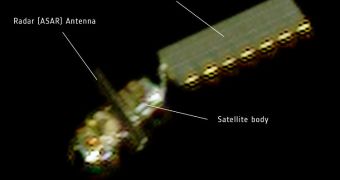According to a statement made by officials at the European Space Agency, mission controllers have yet to reestablish contact with the organization's flagship Earth-observing satellite, Envisat. The spacecraft unexpectedly stopped sending data to Earth on April 8.
Since then, experts have been working on the problem, trying to figure out what went wrong with the 10-year-old satellite. None of the solutions they attempted to implement yielded positive results.
On the bright side of things, recent observations of the spacecraft, conducted using optical telescopes, radar scans and lasers, demonstrated that Envisat is still in a stable orbit around the planet, and holding.
One of the priorities of the ESA team is to determine whether or not the satellite has entered “safe mode,” a survival state in which instruments are shut down, and the spacecraft only conducts minimal operations to ensure a steady power supply.
If experts establish that this mode is active, then they have a solid starting point in their efforts to reestablish contact with the satellite. In the meantime, European countries are supporting ESA in its efforts to image Envisat.
France, for example, made its high-tech Pleiades satellite available to the agency. Normally, this spacecraft is used to capture extremely-high-resolution images of Earth's surface, but it was recently maneuvered into a position that enables it to image Envisat directly.
When the satellite passed within 100 kilometers (60 miles) of Pleiades, on April 15, the French space agency CNES turned its satellite around, and snapped a series of image to prove that the ESA spacecraft was still intact.
Flight specialists and engineers with the European organization say that the Pleiades images are also helpful for determining the orientation of the satellite's solar panels. This is very important, since Envisat cannot maintain a stable orbit if it loses power.
“We are really grateful to CNES for offering to acquire images of Envisat using their Pleiades and Spot satellites. Additional observations being acquired across the globe show how the international space community has come together to track this veteran satellite,” ESA official Volker Liebig says.
He holds an appointment as the director of the Earth Observation Program at the organization.

 14 DAY TRIAL //
14 DAY TRIAL //